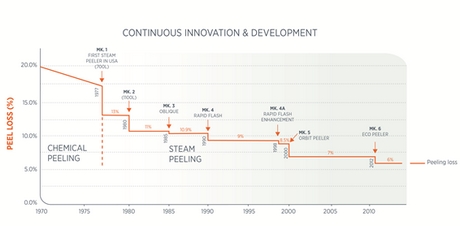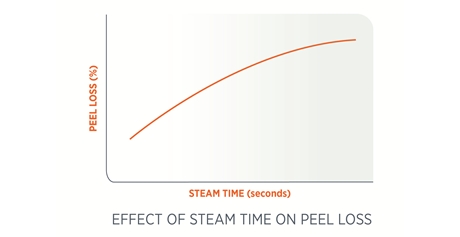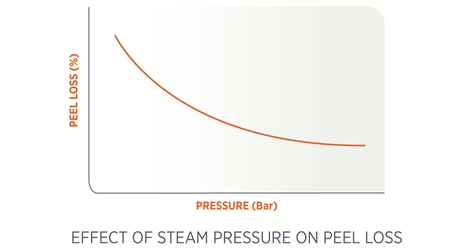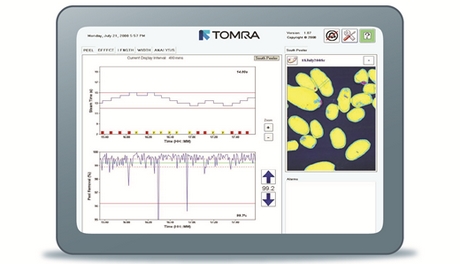
The graph (above) shows yield improvements throughout the past 40 years and each improvement on the graph represents a design change or new innovation by TOMRA.
With the theoretical weight of skin [of potatoes] being measured at between 2 – 3% of the total weight TOMRA had the clear vision of developing processes and technologies that would facilitate the design of a steam peeling line with this 2-3% peel loss as the target.
Steam time and peel loss
The biggest single factor by far in the reduction of peel loss in the steam peeling process is the steam time. A reduction in steam time gives an immediate reduction in peel loss with a corresponding increase in yield. Although there has been a lot of anecdotal evidence as to the benefit of reducing steam time by just one second, TOMRA carried out extensive testing on a range of potato quality and age. This was done with the aim of developing their own algorithms in order to establish this relationship for different conditions, raw product and desired peel quality.

The graph in Fig. 2 shows a typical curve comparing peel loss to steam time. The actual numbers will vary depending on a large number of variables, the most important one being potato size. As an indicator there is a general acceptance within the industry that for each one second of additional steam time there will be an increase in peel loss of 0.3 to 0.5% for French Fry potatoes.
Steam pressure and steam supply system
ODENBERG led the change in developing vessels to handle high steam pressures starting from 6 bar in the late sixties to today, where TOMRA Sorting Solutions is the only company offering vessels designed and certified for 24 bar and most French Fry companies will operate up to 20 bar.
The benefits of high pressure (which gives higher temperature steam) are generally accepted to be a reduction in the steam time required with a resultant reduction in peel loss. Apart from the higher temperature achieved there is another benefit which is a faster flow of steam into the vessel which will further reduce the steam time and peel loss.

The graph in Fig. 3 shows a typical curve comparing peel loss with steam pressure. Again the actual peel loss will vary depending on a number of variables, potato size being the most important.
The steam supply system i.e. boiler, pipework sizing etc. are really critical in terms of eventual peeler performance and they are often forgotten about or wrongly sized. As part of their peeler selection process ODENBERG carried out an audit of the customers’ existing steam supply systems and made recommendations for the new installation. In summary a poorly designed supply system can add seconds to the steam time required resulting in increased peel loss.
Peeling vessel shapes and configuration
The most important element of an efficient steam peeling process is to ensure that each individual potato receives equal and uniform heat/steam treatment. If the steam treatment is not uniform then longer steam times will be required with the resultant increase in peel loss. Over the years achieving this uniform treatment of each potato has been a challenge primarily because of the quantity of potatoes [1200 to 1500 potatoes] in a typical batch and the restrictions of international pressure vessel design codes to the vessel shapes we could realistically use to optimise the mixing of the steam with the potatoes.
ODENBERG has worked with various bottle style configurations (oblique, straight up, squat etc.) up until 1999 when they introduced the patented round vessel with internal agitators. This vessel, called the Orbit was probably the most revolutionary change in rotating steam peeler technology ever and immediately achieved reductions in peel loss of 1.0-2.0% over the bottle design for high preforming French Fry operators.
Vessel rotational speeds
Vessel rotational speeds have increased from 4- 6 rpm in the mid 70’s to rotating speeds of 22rpm in the new TOMRA Eco steam peeling designs. The current high speeds are only made possible because of the finely balanced orbital vessel shape. The high speed combined with the vessel shape and patented lifters/agitators ensure all potatoes are continuously in a state of motion, thus allowing all potato surfaces equal exposure to steam during the complete steam time.
Cycle times and capacity
The capacity of a peeler is determined by the batch weight and the number of cycles or batches per hour. The batch size in turn is determined by vessel size. The other capacity variable is cycle time which determines the number of batches per hour. The cycle time for a batch comprises simply of the steam treatment time plus all other non-steam times. In the mid-seventies these non-steam times varied from 40 to 60 seconds.
However since 1999, the Orbit and more recently the new Eco peeler have been reducing the non-steam times up to 22 seconds. This gives approximately 15 -20% more batches per hour compared to the older bottle design which in turn gives a similar percentage increase in size capacity for size vessel comparison or perhaps more importantly allows a smaller vessel size to be used for the same capacity.
Steam time management and control
All new developments and innovations since the 1970’s have been driven by the need to reduce the steam time required to remove skin from the potato. The control of this steam time, even today in most plants is a manual operation performed by an operator or QC person based on their analysis of the peeled potato. Depending on the operator, this can be hit or miss and in order to play safe and meet the end product specifications, the operator tends to increase the steam time to more than is required which results in peel and yield loss. In the mid 90’s ODENBERG recognised the need for accurate control of steam time changes and designed a peel quality scanner the Peel Scanner², which uses a high resolution CCD camera system to inspect peeled potatoes and based on a pre-set quality control set point, it decides when more or less steam time is required. In plants where current steam time management is good, the introduction of the Peel Scanner² can achieve a peel loss reduction of 0.25 to 0.5%, and in plants where current steam time management is poor, the savings can be much greater. As the scanner can differentiate between peel and all other defects it ensures that the steam peeler is only peeling for skin and not defects (Fig.4).

THE ORBIT REVOLUTION: The driving force behind the revolution
Because approximately 50% of the final cost of the French Fry is the raw potato product, any savings in this raw material has a major effect on the cost of the end product. Peeling is and always has been the one area in a plant where savings are still achievable and targeted. If one looks at the graph (Fig.1) you will see that over the years there has been a constant drive to reduce the losses in the peeling area so it is not surprising that the main driver of innovation was the French Fry industry where even a small reduction in peel loss was important because of the high volumes and the cost of the raw materials.
All through the years in this continuous drive for innovation ODENBERG had one simple design objective when they were developing their machines and it was “Every potato must receive exactly the same thermal treatment during the peeling process and this treatment period (steam time) must be the shortest time possible”.
Over the last 40 years ODENBERG/TOMRA Sorting Solutions adhered rigidly to this goal. Other areas of the potato processing industry such as dehydration, chilled products and other root vegetables such as carrots, swedes, celeriac etc. reaped the benefits of the innovations introduced for the French Fry industry however with a lower return on investment due to shorter seasonal run times and lower costs for the raw materials. One non-potato product which influenced the innovation and design of the Orbit peeler was baby carrots particularly in Europe, where yield improvements of 4-6% were achieved. Baby carrots were the ultimate test for a steam peeler because of their small size and large surface area compared to French
The Orbit design
After only a short time it was concluded that the current bottle vessel technology would not be able to replicate the laboratory results. After much brain storming 35 different vessel designs were reviewed before settling on the current Orbit circular configuration. However the new patented vessel design alone was not considered to be sufficient to achieve the peel loss objectives and the other area of the laboratory results that needed to be scaled up was the near instant exhaust (time to evacuate all steam from the peeling vessel).
This proved to be just as big a challenge as the new vessel design. However after two years design and testing the ODENBERG XP valve was born. The new design addressed two major issues: exhaust times of 1 second or less and substantially longer valve life when compared to existing plug and ball valves. In keeping with continuous development, the XP Valve has since been redesigned as part of the Eco project to give an even longer life (at least double).
Ultimate high yield peeling module
ODENBERG now TOMRA Sorting decided after ten years supplying only steam peelers that some of the gains achieved by an efficient well run peeler were being lost by the incorrect selection and location of post peel equipment such as brushers etc. This led to the development of a Dry Peel Separator which replaced brushers immediately after the peeler giving a substantial reduction in flesh losses while still achieving the dry peel separation. A peeling line now allows for much shorter and more yield efficient steam times combined with a 3 way sorter which directs defect potatoes to a re-peel line. The development of the ODENBERG/ TOMRA Sorting whole potato sorter range, particularly the 3 way Halo sorter has revolutionised the whole re-peel concept. Re-peeling allows the producer to steam peel optimally for the majority of potatoes with low defect levels and then send the remainder with unacceptable defects levels to the re-peel line. The overall result is an overall lower peel loss with higher yields.
Value of a 1% reduction in peel loss
While processors have many detailed and sophisticated formulae for calculating yield savings and total line efficiency, the largest potential for savings is with the peeling module i.e. the complete peeling line and not just the steam peeler. In its simplest form a reduction in peel loss of 2% means that 2% less potatoes are required for the same output at the end of the line. Clearly the savings calculation would be different if the same input to the line was maintained which would result in a higher yield output to packaging however this calculation varies from producer to producer and is dependent on the end product specification, variety of potatoes and numerous areas of line efficiencies of which we would have no knowledge. For the savings calculation we will assume a reduction of 1% in peel loss for a line rate of 30,000 kg/hr and 6,000 operating hours. The other major factor in the calculation is the price of potatoes. Historically the price fluctuates from year to year. As an example for raw product cost of €125 per ton, the savings for a 1% reduction in peel loss would be €225,000 per year.
(Calculation: 6000 hrs/year Operating Time x 30 ton/hr x 0,01% Peel Loss Improvement x €125/ton = €225,000) and pro rata for higher peel loss saving and potato price.
The new Eco Peeler from TOMRA Sorting Solutions
The Eco peeler was designed keeping in mind the fact that the steam peeler is the second highest user of steam in a French Fry plant. This and the continuous drive for improved yields were the main drivers behind the Eco development. The Eco peeler was launched at the Northwest Expo in Portland, Oregan earlier this year. Compared to its predecessor, the Orbit which is the universally accepted leader in steam peeling technology since 1999, the Eco has been designed primarily to provide lower energy usage and the ongoing attainment of reduced peel loss. The benefits and advantages of the new Eco design can be summarised as follows:
• Reduced energy/steam consumption of up to 25%. [Worth c. €50,000 to €80,000 per year depending on local Energy Costs]
• Improved process/peeling characteristics i.e. faster come up to pressure/shorter steam time/quicker exhaust.
• Peel loss reduction [average] of 0,5% compared to Orbit have been achieved and validated
• Improved and more uniform steam treatment of all individual potatoes with new internal agitator configuration combined with increased/higher vessel speeds (22 rpm)
• New process and steam control software with inbuilt diagnostics and steam optimisation algorithms.
• Reduced cost of ownership with new XPT exhaust valve and new high volume door.
• Higher capacity of up to 25% compared to same size peelers.
Conclusion
With current average peel losses of 5-6% one must ask the question as to whether the industry and TOMRA can go much lower. If we look at the theoretical amount of peel on a potato we can assume its somewhere in the region on 2-3% depending on the potato size (there is much discussion and disagreement as to what the number is). While the Eco will be the industry leader for some years to come, TOMRA Sorting Solutions will continue to research new ways and methods to improve the peeling process further.







